Art and script in ancient Egypt
Variations in the integration of Art and Script
Contents
rules of orientation
variations in the integration/separation of image and
script:
-
fusion
-
unmarked separation
-
marked separation
-
combinations
-
script without image
stelae of the first millennium BC
|
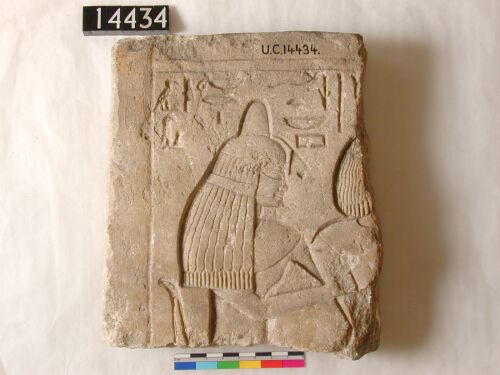 |
Rules of orientation
There are two essential rules of orientation of Egyptian hieroglyphs:
- signs face the start of the line (so an animal, bird or human figure
should point you to the start of the line)
- signs relating to an image face in the same direction as that image
These rules are so normative that they can help reconstruct the
whole image from a surviving fragment.
Example: UC 404 - a fragment of a stela from Amarna, originally
with an image of king Akhenaten and
his principal wife Nefertiti on the left, with the sun-disk in the middle. The
images are lost except for part of the sun-disk (Aten). However, the hieroglyphic
inscriptions identify the positions of the figures and the direction each figure
faced. Use the central ankh-sign to orient yourself in the upper line.
Question: on stela fragment UC 404, where was Akhenaten, and in
which direction did he face? how do you know?
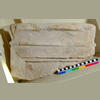
Click here for a drawing
of the stela and a guide to the orientation of signs.
Variations in the integration of Art and Script
There are several ways in which the ancient Egyptian artist combined
script and writing.
1. fusion (full integration) - fully intertwined image
and words
Formal art and hieroglyphic script together project a particular
vision of the world, both communicative (conveying information) and performative
or active (creating an ideal reality in material that can last forever); this
combination belongs to, and constitutes, a 'horizon of eternity' in opposition
to the mortal horizon of everyday life. This fusion is typical of monumental
sacred architecture on all scales, for the cults of the gods (temples), the
cults of kings (temples of the royal cult), and the cults of the blessed dead
(offering-chapels, most located over the burial place, many at other sacred
places such as the area bordering on the temple of Osiris at Abydos).
In the temple relief fragments in the Petrie Museum, the 'horizon
of eternity' is created in the fullest integration. Note that the columns of
script do not have dividing lines.
Example 1: UC 14785, a block from a building dated to the reign
of king Amenemhat I (about 1975
BC) at Koptos
Question: in the depiction and inscription for the ka (soul) of
the king, do you think it is possible to draw a border-line between image and
script?
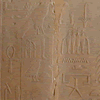
Click here for
a guide to the arrangement of hieroglyphs and images
Example 2: wall reliefs from a building dated to the reign of
king Nubkheperre Intef
(about 1600 BC) at Koptos
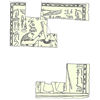
Click here
for a guide to the arrangement of hieroglyphs and images
2. unmarked separation - separate fields of script and
image, without a framing line between image and script
Image and script offer different possibilities for communication:
- an image is less directly verbalised (associated with a word): when you
see a picture of a woman, you could attach many different words to that image
(for example: woman, wife, mother, daughter, rich woman, poor woman, foreigner)
- script verbalises (it provides specific words) - but leaves the visual association
to the imagination: when you read the word 'daughter', there is no ambiguity
over the word, but the image in mind varies according to your present circumstances
and relationships
Given these different communicative possibilities, it is understandable that
there is a tendency for script and image each to acquire their own field within
a composition, compromising the fusion of art and script seen in the most integrated
examples (option 1 above). However, the rule of orientation of signs continues
to unite the script field and image field.
Example 1: UC 14226, burial stela of the king's daughter Neskhons, from her
burial at Thebes, dated to Dynasty 21 (about 1000 BC)
Question: from the rules of orientation (see top of this page), see how many
lines belong with Neskhons, how many with the god
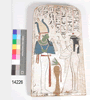
Click here for
a guide to the arrangement of hieroglyphs and images
Example 2: UC 14480, lintel from the offering-chapel of Sepaankh, dated to
Dynasty 19 (about 1250 BC)
Question: from the rules of orientation (see top of this page), see how many
lines belong with Sepaankh, how many with the god
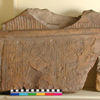
Click here for a guide
to the arrangement of hieroglyphs and images
3. marked separation - separate fields of script and image, with framing
line between the two
The separation of script and image can be taken further, by the introduction
of an internal framing line between the image field and script field. However,
this additional separation is diminished in ancient Egyptian formal art and
hieroglyphic script by two factors:
- a hieroglyphic script field without large images nevertheless comprises
signs that are formed according to the same principles as those underlying
formal art, and hieroglyphic inscriptions include both logograms (words written
with a single sign depicting the object) and, most importantly, determinatives
(images at the end of a word to identify the category of words to which it
belongs)
- a separated image field generally still contains internal captions in the
hieroglyphic script to avoid ambiguity over identifications - for example,
to identify which king or god is depicted, or which member of a family is
depicted
Example: UC 14334, the Abydos offering-chapel stela of the herald
Shenu, Dynasty 12 (about 1900 BC)
Question: in the image field, one individual is identified by
script only - which one? why do you think there is no image of that individual?
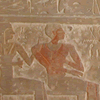
Click here
for a guide to the arrangement of hieroglyphs and images
4. combinations of options 1-3
Compositions regularly present combinations of options. The principle
of combination can best be studied from the more substantially preserved examples
of monumental architecture: the more ambitiously varied artistic programmes
may be absent from smaller monuments, for reasons of scale, and are generally
lost in the case of buildings from which only small fragments survive. Nevertheless,
this broader horizon is often present, and the viewer of the fragment needs
to attempt in each case a mental reconstruction of the ancient visual experiences.
Example: UC 14481, a block from a building dated to the reign
of king Ramesses III (about 1175
BC) at Koptos
Question: consider the same question as for option 1 above, on
the integration of script and image to depict the ka (soul) of the king - note
that in this instance the figure is involved in an action combining this local
script+image field with the local script+image field depicting the throned king.
Now consider the broader pattern of script and image fields, dividing the composition
into parts: how tight are the dividing-lines between script and image overall,
and in each part of the composition?
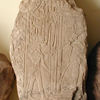
Click here for
a guide to the arrangement of hieroglyphs and images
5. script without image
Image fields without hieroglyphic captions are rare in the surviving
sources, except in lower-status and so non-literate environments.
Script fields without large visual images are less rare, though
fragments may be misleading, as the image may have been lost.
Question: is the following hieroglyphic inscription a composition
without images?
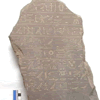
Look for other instances where you only see hieroglyphs in a composition
- is there an image in the broader context, or is it genuinely an image-less
composition?
Pictorial summary of the range of options in combining script
and image
Stelae of the first millennium BC
These illustrate a general trend from an early phase, in the
earlier Third Intermediate Period (about 1000-850 BC), to a late phase, in
Dynasty 30 and the Ptolemaic Period (about 400-30 BC). The development is
gradual and not unilinear, so expect variants and exceptions in each period.
Nevertheless, there is a very marked general trend from dominant image to
dominant script.
Early phase: dominant image, with main script field as caption
over the image, and perhaps just one line below
Late phase: dominant script, with smaller image above the script
field
Examples from early to late phases
|
script over image
|
script over image
|
script moved to side of image field
|
image over script
|
|
|
|
|
|
Copyright © 2003 University College London. All rights
reserved.
